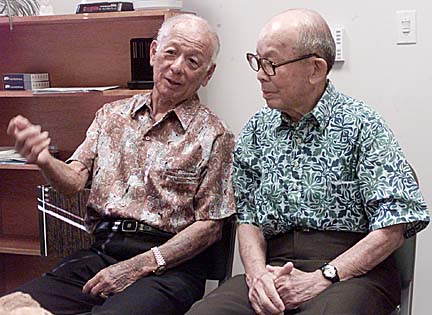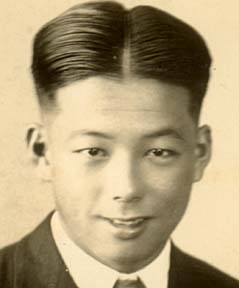


36-year study probes Honolulu volunteers in a unique 36-year study are leaving a rich legacy of health information as they approach or pass their 100th birthdays.
the secrets of life
Researchers in Hawaii studied more
Volunteers young at heart
than 8,000 Japanese Americans
to learn how to stay healthy
even in the later yearsBy Helen Altonn
haltonn@starbulletin.comThe Honolulu Heart Study and offshoot Honolulu-Asia Aging Study have resulted in more than 300 publications related to aging, stroke, dementia, heart and other diseases.
"We've been able to learn many things about how people should live their lives and what's important in health by following these men," said Dr. David Curb, University of Hawaii professor of medicine and geriatrics.
"Our objective is to try to understand what we can do to tell future generations 'this is what's important to live a long, healthy, functional life and to enjoy life through its duration,'" said Dr. Lon White of the Pacific Health Research Institute.
The study began in 1965 with 8,006 Japanese-American men on Oahu chosen from the World War II Selective Service registration file. About 2,453 are still living.
The youngest is 82 and there were two centenarians last year. Three turn 100 this year and eight more next year.
White said, "The likelihood that there will ever again be a study so rich and so large and goes on so long is very small."
With vast amounts of data collected on the men, he said it's important now to study the causes of health and disease in their children.
Curb said several proposals have been funded to see if the children and grandchildren will be as healthy as their parents. The Japanese-Americans also are being compared to people in Japan, he said.
Curb and White are principal investigators for different studies in the program, funded largely by the National Institutes of Health and National Institute on Aging. Other key researchers are Drs. Helen Petrovitch, Kamal H. Masaki and G. Webster Ross.
Because of the age and time that the volunteers were recruited, White said many had been involved with World War II and even those who didn't serve "felt an extraordinary sense of loyalty to their community and to the United States in general."
This was illustrated "by their willingness to accept a lifetime commitment" to the research program, he said.
"What we have now is a resource that is absolutely without peer anywhere in the world and allows us to address extremely important questions regarding the cause of these diseases and the reason some people escape diseases."
Tests sometimes take two to four hours, White said. "We ask a lot of questions, which are pretty personal, and typically 80 percent of the people we ask to come in do. Those who didn't often weren't well enough to." The researchers probably will go to the homes of about one-third of the men for future exams, he said.
Curb said one of the most interesting things about the volunteers is their extraordinary dedication to the research effort. "When you've got partners like that, you can do a lot of things."
He said comparisons to other populations show the Japanese-American volunteers live longer than any other large group in the world. "Their life expectancy is remarkable."
He is interested in "why they're so successful at aging. They live a long time and, on average, are in very good shape for people their age."
Many have common ailments of aging people, Curb said, "but they've done a very good job of accommodating to the problems."
Their risk factors for heart disease are similar to Caucasians but their heart disease rates are about half of what they are for Caucasians at the same age, he said.
Their stroke rates also are lower than Caucasians, Curb said. "So there are some very special things about these people that we still don't understand, even after all this time of studying them."
White said information has been banked in a computer and serum stored so researchers can ask significant questions about the aging process and signs of underlying disease. "We're most interested now in conditions affecting the brain and intellectual functioning."
He said about 20 percent of the men have indicated a willingness to have autopsies, giving the researchers an opportunity to look at the most subtle markers for Alzheimer's, Parkinson's and other diseases.
Post-mortem brain exams show three to four times more men have the underlying process for Alzheimer's than actually have the disease, so they were able somehow to avoid it, White said.
"Even people with a lot of arteriosclerosis in their hearts and blood vessels don't necessarily have strokes or heart attacks," he pointed out. "A lot of people who have lost calcium from their bones don't get fractures.
"Our job, in trying to make the lives of ourselves, our children and our grandchildren happier, longer and more functional, is to understand those processes, what determines who gets a disease process, and what determines who avoids a disease and who gets the disease."

When William Hiraoka and Horace Taba were asked among 8,006 Japanese-American men on Oahu to volunteer for medical studies in 1965, they didn't hesitate.
2 Oahu men's lives are part
of medical research historyBy Helen Altonn
haltonn@starbulletin.comThey became part of the world-renowned Honolulu Heart Program, a research effort that began at Kuakini Medical Center and has continued for 36 years. A Honolulu-Asia Aging Study was added to the program in 1991.
Studies of the men have led to greater understanding and knowledge of heart disease, stroke, Alzheimer's and Parkinson's diseases, dementia and other diseases of the aging.
Despite their cohort's contributions, Taba and Hiraoka -- both 1935 graduates of McKinley High School -- don't think they did anything special.
"I just felt it was my duty to contribute a little bit," said Taba, who was accountant and treasurer of Arakawa's general store in Waipahu until the family business closed in 1995.
"It was a good cause," said Hiraoka, who retired in 1991 after 38 years at National Mortgage and Finance Co. and Island Insurance, heading both for much of that time. "It was interesting, the different approaches they used ... "

In one test, he noted, the volunteers were attached to instruments during sleep for a dementia study.Hiraoka's belief in "helping the cause" also benefited the Blood Bank, where he donated 62 pints to become a "super donor."
Both with January birthdays, Hiraoka will be 85 and Taba 86. They still drive and maintain a healthy, busy lifestyle.
For example, Hiraoka was involved in the Honolulu Lions' Silver Jubilee last weekend while Taba left for Okinawa for the third world conference for Okinawans, said to be "the longest lived of longest lived" people.
Taba attributes the longevity to diet and work, saying, "They don't talk much about retirement in Okinawa." He is in the Okinawa Genealogy Club and has traced his roots 500 years to royalty in Okinawa.

The two volunteers found much in common during an interview at Kuakini Medical Center, from diets of mostly fish and vegetables to long-time Lions Club affiliations and marriages of 55 and 56 years.Hiraoka gave up smoking long ago and has a small glass of red wine at dinner. Taba never smoke or drank, explaining it's an Arakawa family tradition not to smoke.
An avid golfer, Taba said he walked nine holes every morning at dawn for 20 years until undergoing a new surgical procedure for an abdominal aneurysm in July at Straub Clinic and Hospital. He's back to golfing once or twice a week.
He also was "in the right place at the right time" as one of the first patients for open heart surgery when The Queen's Medical Center opened its cardiac unit 28 years ago, he noted.
Hiraoka, a former surfer, recalled a photo taken of three surfers on a wave with two identified as being in the 1934 and 1935 Hall of Fame. "I was identified as an 'unidentified buddy,'" he laughed.
He said he used to walk up seven flights of stairs to his office, and work out on a stationary bicycle. About one-third of his stomach was removed in duodenal ulcer surgery. Yet he walks about 2.5 miles nearly every day.
Taba's family was from Kahaluu, where Okinawans farmed and grew pineapple for a cannery there. His parents moved to Waipahu during the depression in 1935. Taba worked in a grocery store and went to night school to learn about business and accounting.
At the outbreak of World War II, he volunteered for the 442nd Regimental Combat Team but "they took my brother, not me."
Hiraoka was born in Waikiki and moved around the island because his parents worked for wealthy Caucasian families. "As kids growing up, we really enjoyed some things we would not have enjoyed if our parents were doing something else."
He graduated from the University of Hawaii in 1939 with a business and economics degree and earned a master's in business from Harvard. He was a captain in the Army Counter Intelligence Corps during World War II and was recalled during the Korean War.
Among many stories Hiraoka tells about his war experiences, one of the most memorable was when he went with a major to Gen. Tojo's home in Tokyo in September 1945 to take him to U.S. Army headquarters. He heard a gunshot, broke through the shoji doors and found Tojo in his room in a failed suicide attempt.
"You'd think he would do the hari kari thing," Hiraoka said. "There were swords in his room."
Fast facts to live longer and happier
Among highlights of findings in the Honolulu Heart Program and Honolulu-Asia Aging Study:
>> About 40 percent of people with dementia have potentially treatable disorders that go untreated because symptoms aren't recognized.>> More coffee-drinking may reduce the risk for Parkinson's disease.
>> Japanese-American men appear to have milder cases of Alzheimer's disease than Caucasian counterparts in the United States and Europe.
>> Vitamins C and E taken regularly can protect against vascular dementia and may improve brain function in later life.
>> A traditional Western diet higher in animal fat and protein than a typical Asian diet may lower the risk of stroke-related dementia.
>> Middle-aged people who drink up to one drink a day could have better memory, reasoning and perception in their older years than teetotalers.